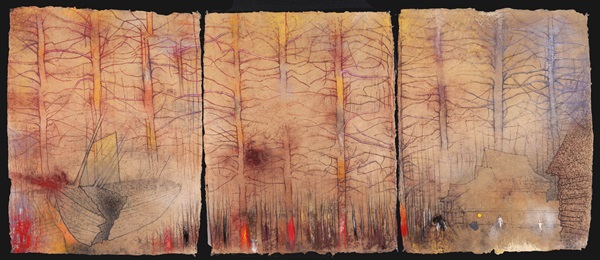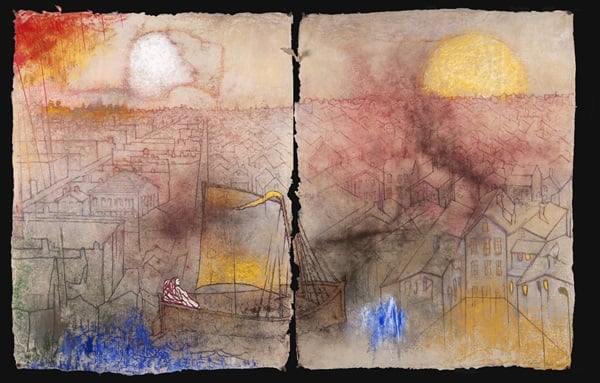Art & Exhibitions
Irving Petlin Looks Back on Five Decades of Painting and Drawing
Primo Levi and Polish writer Bruno Schulz are an inspiration.

Primo Levi and Polish writer Bruno Schulz are an inspiration.

Eileen Kinsella

Seated in the Tribeca loft he purchased in 1976, long before the neighborhood became the Manhattan hotspot it is today, artist Irving Petlin discussed his show at Kent Fine Art in Chelsea, which opens Saturday, November 8. The exhibition, titled “The Still Open Case for Irving Petlin,” will showcase his paintings and drawings from 1960–2012.
“It’s not a retrospective,” says Petlin, but rather “a kind of archaeological dig into my history as an artist, both in terms of the work that I’ve done, the people I’ve been associated with, the issues I’ve been involved in, and the places I’ve been. It’s like going down through the layers of what has been my experience as a painter.”
By all accounts, those layers are deep and colorful. Petlin, who was born in Chicago in 1934, talked about studying at the School of the Art Institute of Chicago in the 1950s during the height of the Chicago “Imagist” movement, painting in an abandoned hotel-turned-studio at night while stationed in San Francisco for a stint in the US Army (there was still a draft, he points out), and relocating to Paris in the 1960s. He recounted how he and his wife Sarah felt obliged to return to the US at the first glimmerings of the Vietnam war and joined forces with Mark di Suvero and other artists to create the LA Peace Tower among other acts of protest, while also serving as visiting artist with Richard Diebenkorn, who was teaching at UCLA.
“The origins of my imagery perhaps begin in Chicago,” says Petlin, who at 80, is soft-spoken though with an air of quiet intensity. While the wave of Abstract Expressionism in New York was generating worldwide attention, he says, “there was another school of American painting. In Chicago there was much more of an interest in the human form because many of the earliest of the Chicago artists in the 1950s were veterans returned from World War II who had seen some horrible things. Their art was filled with a kind of powerful energy and imagery about the destruction and the terrible costs that war inflicts on populations and civilizations.”
Despite the vibrant art scene in Chicago, making a living from sales of art there was nearly impossible at that time, Petlin said. Most of the artists relocated to New York or Paris after art school. Petlin himself left for Paris on a fellowship where “I hooked up with the Chicago group that had gone there, including June Leaf, Leon Golub, and Nancy Spero. We formed a little kind of community for a couple of years there,” he says. Upon returning to the United States Petlin and Sarah first lived in Los Angeles and then in New York, where he continued organizing artist protest movements throughout the duration of the Vietnam War.

Irving Petlin, Abandoned Forest (Broken Boat) (2012)
Courtesy of Kent Fine Art.
Petlin and his wife Sarah now reside in Paris for most of the year, returning to New York each summer and fitting in trips to a studio he maintains on Martha’s Vineyard to reunite with children and grandchildren. Nowadays he says “only certain issues really involve me politically. But my work has always had an undercurrent. It’s like a subtext.”
Petlin became inspired by literary figures like Primo Levi and the lesser-known Polish writer Bruno Schulz, who was killed by a Nazi officer in 1942. His visual interpretation of Schulz’s work in particular eventually drew the attention of Polish government officials who invited Petlin to Poland. The invitation was the impetus for the trip he took there with his longtime friend and legendary dealer, the late Jan Krugier, a survivor of Auschwitz, in 1992. During that trip, the two visited the site of the Treblinka death camp.
Petlin has been working with Douglas Walla of Kent Fine Art since 1980, when Walla departed Marlborough Gallery to set up his own gallery on 57th Street. “Little by little I realized I don’t belong at Marlborough,” says Petlin. “I’m not a Marlborough personality.”
Of the current exhibition, he says, “what I’m trying to do with Doug is a show that tries to piece together these various experiences and associations with the art, even though that’s a difficult thing to do.”

Irving Petlin, Storms: Yellow Sail, Chicago (2011).
Courtesy of Kent Fine Art.
“The Still Open Case for Irving Petlin” opens at Kent Fine Art Saturday, November 8, and runs through December 20.